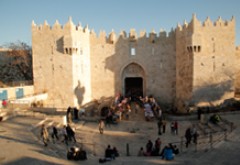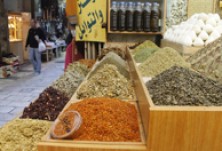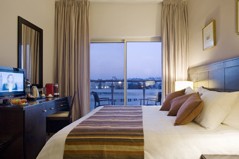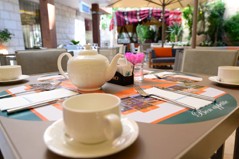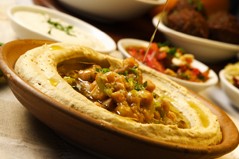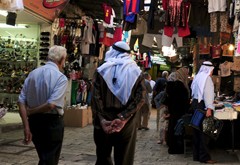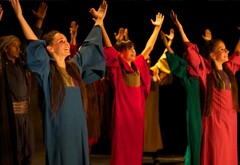Traditional dress in Palestine can be divided into three main categories: Urban, Rural, and Bedouin. While Jerusalem is a city, many of its residents come from the rural areas, and their dress is part of the City's cultural scene, especially since many villages are actually attached to it from all sides, like the village of Silwan, which is a mere 300 meters from the Old City walls.
Jerusalem men, prior to the gradual arrival of the western way of dressing during the second half of the 19th century, used to wear the same type of dress as the rest of Bilad Al-Sham (Levant) men. This is mainly comprised of loose pants, made from wool during the winter season and from cotton, silk, or linen in summer. Its color was originally black, with brown, grey, or dark blue variations. The upper body would be covered with a loose shirt with some embroidery, covered by different types of jackets or gowns. Others wore the Kumbaz, a single piece of cloth which covers the entire body, from the neck to the ankles, and wraps around the body. The waist is surrounded tightly by a wide strip of ornamented cloth. Men covered their heads either with the high Ottoman Tarboush (Fez) or a short one around which a strip of emblazoned cloth is wrapped, or by a white or white and black Kufia.
The women of the city of Jerusalem wore a long dress covering the entire body on occasions, normally made of purple or russet velvet, embroidered with plant motifs of leaves and branches, and geometric forms, using gilded yarn. Their head-cover was a transparent silk scarf embroidered with gilded thread. This dress-method was named "Sarma" and was normally worn on happy occasions. It was common in Ottoman cities, including Jerusalem.
Jerusalem women also wore the Bilad Al-Sham (Levant) dress, composed of a light black knee-high coat (cape), and a black scarf covering the head, with a transparent black cloth extending from it to cover the face. Older women wore a loose black, white, or dark blue skirt, and a white loose shirt. The head was covered with a transparent scarf (Shashiyah). Their faces remained exposed.
Jewelry was basically gold and included necklaces, bracelets, and earrings. These varied according to fashion in the Ottoman Empire and later on, the world. Some Jerusalem women wore village and Bedouin silver jewelry.
Each village around Jerusalem had its own dress, which could be easily distinguished from its shape and embroidery. Collectively, these are referred to as the Palestinian embroidered dress, named differently in each village. Hence, there are dozens of different women dresses in Palestine, distinguishing the coast from the mountain and the north from the middle and south. Such dresses can also be classified into groups, based on the shape of embroidery or the type of fabric used. This diversity also applies to head-covers, belts, and jackets, let alone jewelry and accessories.
As a result of this diversity, Palestinian women dresses carried different names. In the villages of Silwan, Dair Yassin, and Al-Malha, it was called "Ghabnah. In Aizariyah, it was called "Asawri," (Thawb Abu Qutbah" and in Lifta, it was Janneh ou-Nar "Heaven and Hell". In Bethlehem area it was "Thawb Malek" (the King's Gown), ad in Ramallah, "Thawb Rumy." It was either white or black.
The loose Thawb was normally made from cotton or silk cloth material and covers the body from neck to ankles. It was embroidered extensively on the chest, neckline, sides, edges, and sleeves, using silk gilded thread in different colors, with plant motifs of plants, flowers, leaves, and straight and zigzag lines. The different parts of the Thawb were embroidered separately and then connected together with ornamental ribbon. The Thawb was characterized by a very small cross-stitch and absolute accuracy, forming a work of art.
The head-cover was also very varied, and each village had a different style, ranging from a simple scarf whose edges are embroidered with small flowers or plant motifs in different colors, as is the case in Lifta village, or a hat type called Tarboush or Shatweh in a dark red or russet color, with gold or silver coins, together with beads lined on its edges. The back of the head-cover was embroidered in the same way as the Thawb. A white scarf hangs over the head-cover (Bethlehem). In the Ramallah area, women wore a silk shawl in different colors, ornamented with embroideries in different colors, covering part of the head and hanging down the shoulders towards the back.
The Jerusalem rural women sometimes wore a short black or russet velvet jacket embroidered heavily either with gold thread or with pink, red, and blue thread, in various plant motifs or floral and geometric shapes.
The belt had an important place in the attire. It is a strip of cloth, normally striped silk or embroidered linen, and is wrapped around the waist, holding the dress up so it does not drag on the ground.
Jewelry was normally bracelets, anklets, earrings, necklaces, and belts. It is a rural tradition to use silver, sometimes inlaid with precious stones. It is very rare to find gold jewelry, except on head covers (Ottoman Dinars). Jewelry differs from one region to another, but the prevailing motif is plants and geometric shapes. It is exciting to see some pieces of jewelry that are large in size and that sometimes had a box used to place phylacteries prayers. Necklaces and earrings used were also made of beads or Ottoman coins.
Men in the Jerusalem rural areas wore the Kumbaz, referred to above, and sometimes loose pants. The Kufiah normally was the common head-cover. On special occasions, a white or beige Kumbaz was worn, with a light brown or beige cape with gilded edges above it in summer, and a heavy wool cape in black or brown in winter.
The Palestinian embroidered dress has become a well-known Palestinian identity throughout the world, and many museums around the world strive to have a collection of dresses, considering them high-value artistic pieces. It is also collected by large numbers of art collectors in the world.
In Palestine, many museums have good collections of Palestinian dresses, such as Baituna Al-Talhami (Our Bethlehem Home) in Bethlehem, the Arab Child Home Museum in Jerusalem, the Family Revival Association in Al-Bireh, and the Bir Zeit Museum, in addition to large individual collections throughout the West Bank.
It is rare nowadays to see Palestinian peasant women wearing this Thawb, but it has not altogether disappeared. Women in Palestine and in the diaspora wear it as an expression of their identity and a show of their historical rights. This is an outcome of the 1948 war in which many villages that wore this Thawb were destroyed, but women continue to wear it on occasions in adherence to their heritage and longing to their homeland.

